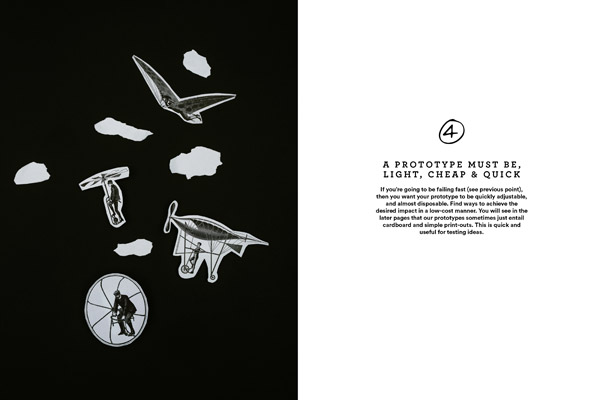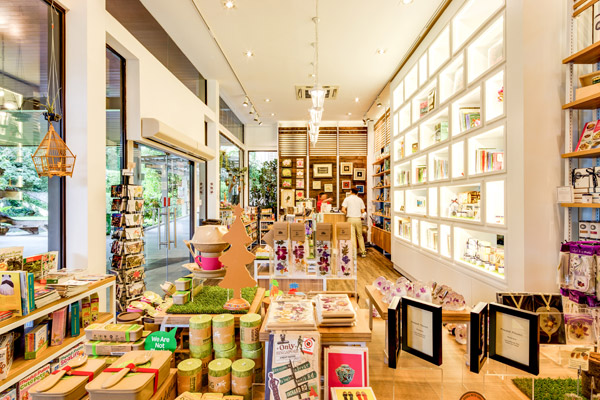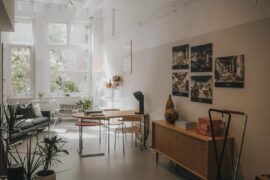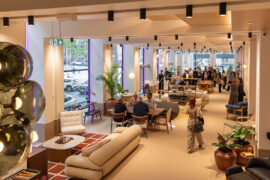For Cubes Indesign 77, we visited fast-casual restaurant Grain Traders and experienced its holistic design crafted by ONG&ONG Experience Design Studio. Here we dive deeper into the studio’s design process via its new book. Stephanie Peh reports.

January 5th, 2016
Top image: Let’s Experience Design, a publication by ONG&ONG Experience Design Studio
Let’s Experience Design, a publication by ONG&ONG Experience Design Studio, aims to guide and inspire anybody (not just designers) to build honest experiences that stem from ground zero. The hardcover book conveys a design process that is paramount to the studio’s body of work. Authored by Mark Wee and Ken Yuktasevi, both Directors of the ONG&ONG Experience Design Studio, Let’s Experience Design is backed by actual observations and narratives drawn from the projects the studio has undertaken over the years.
Asserting that “Design is for everyone,” ONG&ONG Experience Design Studio defines its process with five steps: Discovery, Synthesis, Ideate, Prototype and Design. Each step informs a chapter within the publication. The Directors began developing the approach when they were running their own practice in 2006. Over the years, the process was refined in collaboration with team members and later within the ONG&ONG group, to make it accessible and understandable to clients. “Every time we meet a client, we spend time educating them on our process, and how we approach design from a more holistic view,” says Wee.
Step one (Discovery) is perceived as an initiation process that steers every project. Going beyond the brief is necessary and important to reap valuable findings. The writers suggest methods such as interviews, workshops, surveys and case studies – these may be mixed and matched to suit various applications – to uncover layers.
Once enough information has been collected, step two (Synthesis) refers to making sense of, or finding inspiration in, data. Deemed a challenging process, this chapter prepares readers for potential roadblocks, inspiring one to perserve, or perhaps backtrack if required. The studio’s work for F&B chain Salad Stop (referenced in the chapter) was based on four customer personas originally crafted during the Synthesis stage. This led to the establishment of a framework that guided and shaped the next step.
The third chapter (Ideate) opens with the suggestion that in future, individuals across different fields, rather than designers alone, will work together to achieve the best creative solutions. It emphasises that “no idea is a bad idea,” sharing how the studio managed to “think out of the box” when tailoring a banking experience for Gen-Y users of Frank by OCBC. An interactive “shopping experience” was implemented, spicing up an otherwise mundane activity.
The fourth step (Prototype) encourages the reader to conduct actual ground tests to prove the credibility of ‘absurd’ or risky ideas and affirm assumptions. Finally, a chapter on the fifth step (Design) concludes the easy-to-read publication with story-like narratives of end users’ perspectives.
 |
|
Step 4 – the Prototype stage
For ONG&ONG Experience Design Studio, every part of this five-step process is important, as they inform one another and contribute to a greater whole. When asked if the approach would alter in future, Wee says, “We are now applying the process to larger-scale work in architectural and master space planning. These are more complex, as they involve cities. We feel that it [the five-step process] will be refined with these.”

Singapore Botanic Gardens Shops
Let’s Experience Design was written by Mark Wee and Ken Yuktasevi of ONG&ONG Experience Design Studio and is published by ORO Editions.
ONG&ONG
ong-ong.com
INDESIGN is on instagram
Follow @indesignlive
A searchable and comprehensive guide for specifying leading products and their suppliers
Keep up to date with the latest and greatest from our industry BFF's!

Sydney’s newest design concept store, HOW WE LIVE, explores the overlap between home and workplace – with a Surry Hills pop-up from Friday 28th November.

At the Munarra Centre for Regional Excellence on Yorta Yorta Country in Victoria, ARM Architecture and Milliken use PrintWorks™ technology to translate First Nations narratives into a layered, community-led floorscape.
The internet never sleeps! Here's the stuff you might have missed

Designed by RADS, the space redefines the lobby not as a point of passage, but as a destination in itself: a lobby bar, a café, and a small urban hinge-point that shapes and enhances the daily rituals of those who move through it.

Stylecraft opens its new Collins Street showroom, unveiling curated design spaces and Ross Gardam’s Dwell collection.